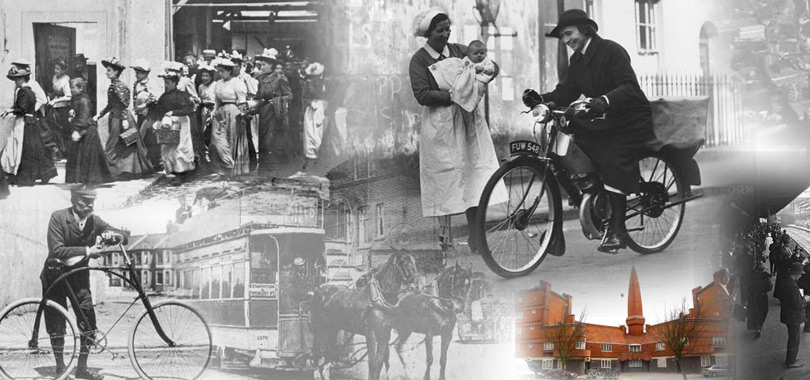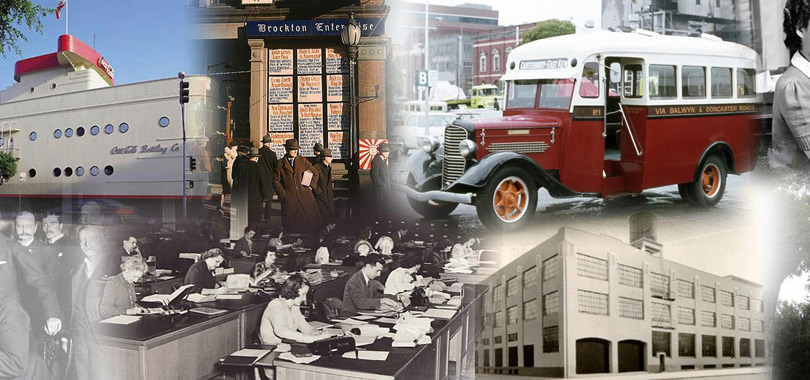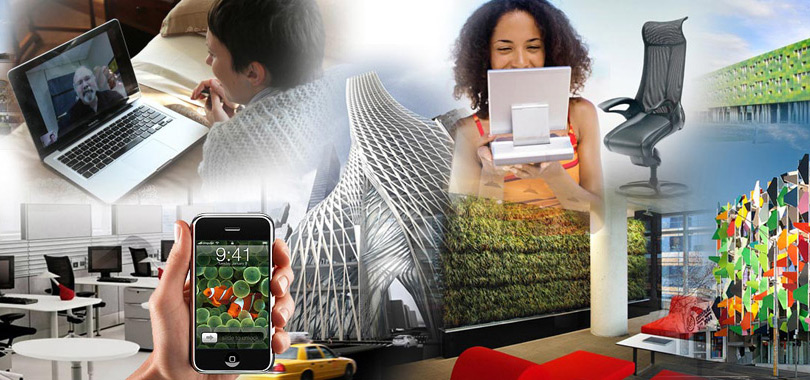Changes through time: Business, Technology, Architecture
1900s
PrintCloseThe early 20th century saw the rapid development of urbanisation through the growth in factory work and industrial inventions. Prior to the 20th century, in the preindustrial era, people tended to work in the home combining a range of work-related activities (e.g., farming the land for produce for individual use and sale alternated by the construction of craft items in the home for sale). Work and leisure activities were integrated with time regulated by the seasons. With the advent of industrialism, small-scale paid work was taken out of the home environment and located into large-scale factories. Clock time introduced an external disciplining control force affecting workers lives as their attendance was monitored by a punch card time system.
While this began an era of economic and societal tumultuous innovation and change, the focus was on ‘technological’ inventions. In contrast, signalling the birth of management , work activities were broken down into fragments which denied workers the opportunity for creative expression and the control-orientated people management approaches taken effectively repressed the initiative of workers (see Charlie Chaplin’s movie Modern Times).
1920s - 1950s
PrintCloseThis era reflected the birth of the Human Relations movement where the famous Hawthorne experiment in Chicago conducted by a research team, involved in a lighting company study, led to the realisation of the importance of social interaction for people in the work environment to allow them to learn from each other and thus become more connected to their work activities again. This study marked a shift in understanding in relation to the psychosocial needs of employees regarding elements of job satisfaction, and discretion in their work activities, to make work more meaningful. As the early era of industrialism had seen significant problems with staff retention rates, this increased awareness of the importance of work to people's lives led to the creation of the Tavistock Institute in the United Kingdom. This research body was dedicated to a productive relationship between work and individual well-being premised on evidence gained from social science studies of workplace relations and continues to perform important research to this day s (ee Keith Grint's the Sociology of Work text).
1960s - 1970s
PrintCloseThe growing awareness of the relationship between people power and productive output led to personnel managers playing a productive mediating role between employers and employees through the focus on achieving job satisfaction as linked to productive output. Pockets of the renewed valuing of craft activities began to grow with the more integrated nature of the work activities enabling the expression of individual initiative and discretion on the part of workers and leading to quality products being produced en masse. This era was marked by groundbreaking innovations in design in the textile industries, in particular, as well as the building industry and other large-scale industry production. The growth of mass popular consumption took hold in this era facilitating more competition between companies in relation to creative output (see the HBO series Mad Men and Australia's Paper Giants).
1980s - 2000s
PrintCloseThis era witnessed the saturation of mass-market potential and ushered in what is called post-industrialism with many of the features of preindustrialism beginning to emerge. For example, as companies recognised the niche marketing of quality produced, value adding, items could enable their survival, the introduction of total quality management (TQM) procedures signalled a new focus on the rights of the customer. Hence, the focus shifted from quantifiable output to high-quality goods and services. This required a radical shift in managing people processes to gain the kind of commitment required for employees where they would no longer have a manager watching over their shoulder. Instead employees would be expected to take responsibility for the quality factor themselves. The intention was to have staff (now referred to as ‘employees’) contributing levels of heightened initiative which would allow companies to survive the growing conditions of global competition that was taking hold. The way to gain the necessary commitment was seen to be by creating a corporate ‘culture’ in which people felt a sense of connection. The role of the personnel officer shifted to a human resource management function involving the task of increasing morale through the provision of flexible working conditions balanced by increased performance expectations that HRM would set for staff. Innovation was said to be the domain of people yet research shows that training and development opportunities were restricted to technological areas like ‘information technology’ (IT) rather than the broader framing of everyday people processes (see the British TV series The Office). This signalled an ongoing Modernist love affair with technology and the continuing devaluation regarding the centrality of people to produce innovative organisational potential.
2000s to the present
PrintCloseThis era has been marked by instability and turbulence in the global environment and competition to survive has become heightened and intensive. Consequently, organisations have had to reinvent themselves to come up with new ways of creating innovative ideas and practices and talent management has been a core driver in this domain. With the advent of global communications systems like the Internet and the growth of social media modes of interaction, the old command-and-control style of managing people is giving way to more decentralised, facilitative approaches as organisations are increasingly dependent on the innovative capacity of their staff to lead the way. Hence the focus is shifting gradually to sustainability in terms of economic, social, cultural and environmental investment.
The banks in particular (although popularly seen as bureaucratic and conventional in their thinking) have led the way in their design of revolutionary workspaces to cater to these new forms of interactive networking ways of working. For example, they provide libraries spaces for people to work in where the employee gets to design their own chairs and the creation of green spaces allows them to dip their toes into watery ponds and enjoy the greenery of a garden while interacting with fellow team members (check out the ABC radio program By Design).
Mirroring preindustrial times, the task structure becomes much more integrated and work and leisure boundaries break down with the home again becoming a site for work output. The ‘culture’ focus is now much more defined with the term ‘Enterprise’ signalling creativity as the driving force for all manner of organisations. These are depicted as taking a post-bureaucratic organisational form and enterprising is what employees are expected to be behaviourally. Hence, the HR role shifts to a strategic one in which managing people to meet business strategic ends is key to ensuring the company not only survives but thrives in this ‘knowledge economy’, innovative driven, environment. It is this contemporary and future orientated context that this course explores to ascertain how the strategic human resource management role fits into this new paradigm. The key role these professionals will play in the next few decades is addressed and critically analysed, through an innovative, interactive student-focused, creative learning format, to equip students with meaningful understanding of the many and varied issues surrounding this professional vocation today.












- 1900s
- 1920s - 1950s
- 1960s - 1970s
- 1980s - 2000s
- 2000s to the present